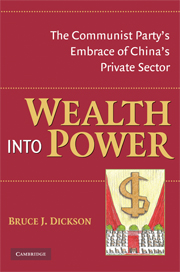Book contents
- Frontmatter
- Contents
- List of Tables and Figure
- Acknowledgments
- 1 Introduction
- 2 The Party's Promotion of the Private Sector
- 3 Co-opting the Capitalists
- 4 Bridges and Branches: The CCP's Institutional Links to the Private Sector
- 5 Views on the Economic, Political, and Social Environments
- 6 Private Entrepreneurs in Public Service: Participation in China's Formal Political Institutions
- 7 The Ripple Effects of Privatization: Corruption, Inequality, and Charity
- 8 Conclusion
- Appendix: Survey Design
- Bibliography
- Index
Appendix: Survey Design
Published online by Cambridge University Press: 05 September 2012
- Frontmatter
- Contents
- List of Tables and Figure
- Acknowledgments
- 1 Introduction
- 2 The Party's Promotion of the Private Sector
- 3 Co-opting the Capitalists
- 4 Bridges and Branches: The CCP's Institutional Links to the Private Sector
- 5 Views on the Economic, Political, and Social Environments
- 6 Private Entrepreneurs in Public Service: Participation in China's Formal Political Institutions
- 7 The Ripple Effects of Privatization: Corruption, Inequality, and Charity
- 8 Conclusion
- Appendix: Survey Design
- Bibliography
- Index
Summary
The data used in this book come from two surveys, the first conducted in fall 1997 and spring 1999 and the second conducted between late 2004 and early 2005 (throughout the book, they are referred to as the 1999 and 2005 surveys, respectively). Four Chinese provinces were selected (Hebei, Hunan, Shandong, and Zhejiang), and within each province two counties or county-level cities were selected (in all, three counties and five county-level cities; one of the county-level cities had become a district of a prefecture-level city by the time of the 2005 survey). The counties were purposively selected in order to have different levels of economic development represented in the sample. The same eight counties made up the 2005 survey, regardless of their current level of development, allowing me to observe trends over time. Although the local rates of economic development varied, the rank ordering of the counties by level of development was nearly identical, with the exception of the sixth- and seventh-poorest counties, which reversed places.
The survey targeted two specific groups: the owners and operators of large and medium-scale private enterprises (those with over I million yuan in annual sales, although as noted below this standard had to be relaxed in several counties) and the local party and government cadres with either general executive responsibilities or particular authority over the private economy. In each county, entrepreneurs were selected from three townships and towns where the private economy was relatively developed for that particular county (in the 1999 survey, a fourth township had to be added for one of the counties in order to get the targeted number of entrepreneurs).
- Type
- Chapter
- Information
- Wealth into PowerThe Communist Party's Embrace of China's Private Sector, pp. 255 - 258Publisher: Cambridge University PressPrint publication year: 2008



